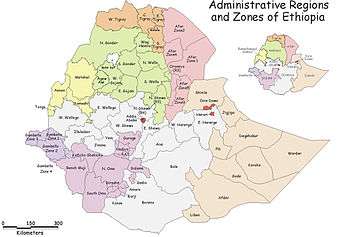Bale Zone

Bale (Afan Oromo: Baale) is one of the zones in the Oromia Region of Ethiopia. Bale is named for the former Sultanate of Bale, which was in approximately the same area.
Bale is bordered on the south by the Ganale Dorya River which separates it from Guji, on the west by the West Arsi Zone, on the north by Arsi, on the northeast by the Shebelle River which separates it from West Hararghe and East Hararghe, and on the east by the Somali Region.
Overview
The highest point in the Bale Zone, and also the highest point in Oromia, is Mount Batu (4,307 m) in the Urgoma Mountains range. Other notable peaks of the Urgoma include Mount Tullu Dimtu, Mount Darkeena and Mount Gaysay. Rivers include the Wabe and the Weyib; notable lakes include Garba Guracha and Hora Orgona. Points of interest in the Zone include Sheikh Hussein—named for the tomb of a Moslem saint—the Bale Mountains National Park, and the Sof Omar Caves. Towns and cities in Bale include Dodola, Ginir, Goba and Robe.
The Central Statistical Agency (CSA) reported that 5,130 metric tons of coffee were produced in this zone in the year ending in 2005, based on inspection records from the Ethiopian Coffee and Tea authority. This represents 4.46% of the Region's output and 2.2% of Ethiopia's total output.[1]
Demographics
Based on the 2007 Census conducted by the CSA, this Zone has a total population of 1,402,492, an increase of 15.16% over the 1994 census, of whom 713,517 are men and 688,975 women; with an area of 43,690.56 square kilometers, Bale has a population density of 32.10. While 166,758 or 26.20% are urban inhabitants, a further 44,610 or 3.18% are pastoralists. A total of 297,081 households were counted in this Zone, which results in an average of 4.72 persons to a household, and 287,188 housing units. The three largest ethnic groups reported were the Oromo (91.2%), the Amhara (5.7%) and the Somali (1.44%); all other ethnic groups made up 1.66% of the population. Oromiffa was spoken as a first language by 90.46%, Amharic was spoken by 7.11% and Somali by 1.05%; the remaining 1.38% spoke all other primary languages reported. The majority of the inhabitants were Muslim, with 81.83% of the population having reported they practiced that belief, while 16.94% of the population professed Ethiopian Orthodox Christianity and 1.04% were Protestant. [2]
The 1994 national census reported a total population for this zone of 1,217,864 in 250,586 households, of whom 603,895 were men and 613,969 women; 130,307 or 10.7% of its population were urban dwellers at the time. The four largest ethnic groups reported in Bale were the Oromo (88.93%), the Amhara (7.65%), the Somali (1.39%), and the Sidama (0.88%); all other ethnic groups made up 1.15% of the population. Oromiffa was spoken as a first language by 87.5%, 9.5% Amharic, 1.51% spoke Somali, and 0.88% spoke Sidamo; the remaining 0.61% spoke all other primary languages reported. The majority of the inhabitants were Muslim, with 76.7% of the population having reported they practiced that belief, while 19.02% of the population said they professed Ethiopian Orthodox Christianity, 2.77% held traditional beliefs, and 1.15% were Protestant.[3]
According to a May 24, 2004 World Bank memorandum, 11% of the inhabitants of Bale have access to electricity; this zone has a road density of 11.4 kilometers per 1,000 square kilometers (compared to the national average of 30 kilometers);[4] the average rural household has 1 hectare of land (compared to the national average of 1.01 hectare of land and an average of 1.14 for the Oromia Region);[5] and the equivalent of 1.0 head of livestock. 19.5% of the population is in non-farm related jobs, compared to the national average of 25% and a regional average of 24%. Concerning education, 66% of all eligible children are enrolled in primary school and 21% in secondary schools. Concerning health, 53% of the zone is exposed to malaria and none to Tsetse fly. The memorandum gave this zone a drought risk rating of 555.[6]
Notes
- ↑ CSA 2005 National Statistics Archived November 23, 2006, at the Wayback Machine., Table D.2
- ↑ Census 2007 Tables: Oromia Region Archived November 13, 2011, at the Wayback Machine., Tables 2.1, 2.4, 2.5, 3.1, 3.2 and 3.4.
- ↑ 1994 Population and Housing Census of Ethiopia: Results for Oromia Region, Vol. 1, part 1 Archived November 15, 2009, at the Wayback Machine., Tables 2.1, 2.7, 2.12, 2.15, 2.17 (accessed 6 April 2009).
- ↑ "Ethiopia - Second Road Sector Development Program Project", p.3 (World Bank Project Appraisal Document, published 19 May 2003)
- ↑ Comparative national and regional figures comes from the World Bank publication, Klaus Deininger et al. "Tenure Security and Land Related Investment", WP-2991 (accessed 23 March 2006).
- ↑ World Bank, Four Ethiopias: A Regional Characterization (accessed 23 March 2006).
Coordinates: 6°45′N 40°15′E / 6.750°N 40.250°E